Electrochemical Sensors Based on Metal-Porous Carbon Nanozymes for Dopamine, Uric Acid and Furazolidone
Abstract
:1. Introduction
2. Experimental
2.1. Reagents
2.2. Instruments
2.3. Preparation of COFTD, CN, MNPs Nanozymes/CN
2.4. Preparation of COFTD/Glassy Carbon Electrode (GCE), M2+/3+/COFTD/GCE, CN/GCE and MNPs/CN/GCE
3. Results and Discussion
3.1. Characterization of COFTD
3.2. Characterization of CuNPs/CN
3.3. Characterization of FeNPs/CN, CoNPs/CN and NiNPs/CN
3.4. Electrochemical Detection of DA and UA by Using MNPs/CN Nanozymes
3.5. Electrochemical Detection of FZ Based on CuNPs/CN/GCE
4. Conclusions
Supplementary Materials
Author Contributions
Funding
Institutional Review Board Statement
Informed Consent Statement
Data Availability Statement
Conflicts of Interest
References
- He, C.; Asif, M.; Liu, Q.; Xiao, F.; Liu, H.; Xia, B.Y. Noble metal construction for electrochemical nonenzymatic glucose detection. Adv. Mater. Technol. 2022, 30, 2200272. [Google Scholar] [CrossRef]
- Kurtoğlu, S.F.; Hoffman, A.S.; Akgül, D.; Babucci, M.; Aviyente, V.; Gates, B.C.; Bare, S.R.; Uzun, A. Electronic structure of atomically dispersed supported iridium catalyst controls iridium aggregation. ACS Catal. 2020, 10, 12354–12358. [Google Scholar] [CrossRef]
- Ahangaran, F.; Navarchian, A.H. Recent advances in chemical surface modification of metal oxide nanoparticles with silane coupling agents: A review. Adv. Colloid Interface Sci. 2020, 286, 102298. [Google Scholar] [CrossRef] [PubMed]
- Chen, Q.; Nie, Y.; Ming, M.; Fan, G.; Zhang, Y.; Hu, J.S. Sustainable synthesis of supported metal nanocatalysts for electrochemical hydrogen evolution. Chin. J. Catal. 2020, 4, 1791–1811. [Google Scholar] [CrossRef]
- Han, Q.F.; Pang, J.B.; Li, Y.F.; Sun, B.J.; Ibarlucea, B.Y.; Liu, X.Y.; Gemming, T.; Cheng, Q.L.; Zhang, S.; Liu, H.; et al. Graphene biodevices for early disease diagnosis based on biomarker detection. ACS Sens. 2021, 6, 3841–3881. [Google Scholar] [CrossRef]
- Chen, X.; Jiang, X.; Yang, N. Graphdiyne Electrochemistry: Progress and Perspectives. Small 2022, 18, 2201135. [Google Scholar] [CrossRef]
- Zhou, W.X.; Shen, H.; Zeng, Y.; Yi, Y.P.; Zuo, Z.C.; Li, Y.J.; Li, Y.L. Controllable synthesis of graphdiyne nanoribbons. Angew. Chem., Int. Ed. 2020, 59, 4908–4913. [Google Scholar] [CrossRef]
- Han, X.; Cao, K.; Yao, Y.; Zhao, J.; Chai, C.; Dai, P. A novel electrochemical sensor for glucose detection based on a Ti3C2TX/ZIF-67 nanocomposite. RSC Adv. 2022, 12, 20138–20146. [Google Scholar] [CrossRef]
- Yadav, P.; Cao, Z.; Barati Farimani, A. DNA Detection with Single-Layer Ti3C2 MXene Nanopore. ACS Nano 2021, 15, 4861–4869. [Google Scholar] [CrossRef]
- Qiu, Q.M.; Chen, H.Y.; You, Z.H.; Feng, Y.Y.; Wang, X.; Wang, Y.X.; Ying, Y.B. Shear Exfoliated Metal-Organic Framework nanosheet-enabled flexible sensor for real-time monitoring of superoxide anion. ACS Appl. Mater. Interfaces 2020, 12, 5429–5436. [Google Scholar] [CrossRef]
- Li, X.; Zhao, X.; Chu, D.; Zhu, X.; Xue, B.; Chen, H.; Zhou, Z.; Li, J. Silver nanoparticle-decorated 2D Co-TCPP MOF nanosheets for synergistic photodynamic and silver ion antibacterial. Surf. Interfaces 2022, 33, 102247. [Google Scholar] [CrossRef]
- Liu, H.; Gao, J.; Duan, C.; Wu, K.; Guo, K. A novel mediator-free biosensor based on hemoglobin immobilized in the Au nanoparticals and TiO2 nanosheets co-modified graphene nanocomposite. Mater. Lett. 2020, 275, 128142. [Google Scholar] [CrossRef]
- Gao, J.; Liu, H.; Wu, K.; Yan, J.; Tong, C. A novel nonenzymatic ascorbic acid electrochemical sensor based on gold nanoparticals-chicken egg white-copper phosphate-graphene oxide hybrid nanoflowers. Nanotechnology 2021, 32, 325504. [Google Scholar] [CrossRef] [PubMed]
- Chakraborty, B.; Roychaudhuri, C. Metal/Metal oxide modified graphene nanostructures for electrical biosensing applications: A Review. IEEE Sens. J. 2021, 21, 17629–17642. [Google Scholar] [CrossRef]
- Mohammed, H.Y.; Farea, M.A.; Ingle, N.N.; Sayyad, P.W.; Al-Gahouari, T.; Mahadik, M.M.; Bodkhe, G.A.; Shirsat, S.M.; Shirsat, M.D. Review—Electrochemical hydrazine sensors based on graphene supported Metal/Metal oxide nanomaterials. J. Electrochem. Soc. 2021, 168, 106509. [Google Scholar] [CrossRef]
- Devasenathipathy, R.; Tsai, S.H.; Chen, S.M.; Karuppiah, C.; Karthik, R.; Wang, S.F. Electrochemical synthesis of β-cyclodextrin functionalized silver nanoparticles and reduced graphene oxide composite for the determination of hydrazine. Electroanalysis 2016, 28, 1970–1976. [Google Scholar] [CrossRef]
- Ji, K.; Zhang, X.; Che, Q.; Yue, Y.; Yang, P.; Jiang, S.P. Composite nanoarchitectonics of ZIF-67 derived CoSe2/rGO with superior charge transfer for oxygen evolution reaction. Electrochim. Acta 2022, 426, 140785. [Google Scholar] [CrossRef]
- Chu, Q.; Lin, H.; Ma, M.; Chen, S.; Shi, Y.; He, H.; Wang, X. Cellulose nanofiber/graphene Nanoplatelet/Mxene nanocomposites for enhanced electromagnetic shielding and high in-plane thermal conductivity. ACS Appl. Nano Mater. 2022, 5, 7217–7227. [Google Scholar] [CrossRef]
- Yang, L.; Li, M.; Kuang, L.J.; Li, Y.; Chen, L.L.; Lin, C.H.; Wang, L.; Song, Y.H. Benzotrithiophene-based covalent organic frameworks for real-time visual onsite assays of enrofloxacin. Biosens. Bioelectron. 2022, 214, 114527. [Google Scholar] [CrossRef]
- Liang, H.H.; Luo, Y.; Li, Y.; Song, Y.H.; Wang, L. An immunosensor using electroactive COF as signal probe for electrochemical detection of carcinoembryonic antigen. Anal. Chem. 2022, 94, 5352–5358. [Google Scholar] [CrossRef]
- Liang, H.H.; Wang, L.Y.; Yang, Y.X.; Song, Y.H.; Wang, L. A novel biosensor based on multienzyme microcapsules constructed from covalent-organic framework. Biosen. Bioelectron. 2021, 193, 113553. [Google Scholar] [CrossRef] [PubMed]
- Wang, L.Y.; Yang, Y.X.; Liang, H.H.; Wu, N.; Peng, X.; Wang, L.; Song, Y.H. A novel N,S-rich COF and its derived hollow N,S-doped carbon@Pd nanorods for electrochemical detection of Hg2+ and paracetamol. J. Hazard Mater. 2021, 409, 124528. [Google Scholar] [CrossRef] [PubMed]
- Guo, L.L.; Yang, L.; Li, M.Y.; Kuang, L.J.; Song, Y.H.; Wang, L. Covalent organic frameworks for fluorescent sensing: Recent developments and future challenges. Coord. Chem. Rev. 2021, 440, 213957. [Google Scholar] [CrossRef]
- Yang, Y.X.; Shen, Y.; Wang, L.Y.; Song, Y.H.; Wang, L. Three-dimensional porous carbon/covalent-organic framework films integrated electrode for electrochemical sensors. J. Electroanal. Chem. 2019, 855, 113590. [Google Scholar] [CrossRef]
- Gu, F.L.; Chen, K.X.; Du, Y.; Song, Y.H.; Wang, L. CeO2-NiO/N,O-rich porous carbon derived from covalent-organic framework for enhanced Li-storage. Chem. Eng. J. 2022, 442, 136298. [Google Scholar] [CrossRef]
- Chen, K.X.; Huang, R.; Gu, F.L.; Du, Y.; Song, Y. A novel hollow Co3O4@N-doped carbon nanobubble film composite for high-performance anode of lithium-ion batteries. Compos. Part B-Eng. 2021, 224, 109247. [Google Scholar] [CrossRef]
- Gu, F.L.; Liu, W.; Huang, R.; Song, Y.H.; Jia, J.; Wang, L. A g-C3N4 self-templated preparation of N-doped carbon nanosheets@Co-Co3O4/carbon nanotubes as high-rate lithium-ion batteries’ anode materials. J. Colloid Interf. Sci. 2021, 597, 1–8. [Google Scholar] [CrossRef]
- Kumar, M.; Wang, M.; Swamy, B.E.K.; Praveen, M.; Zhao, W. Poly (alanine)/NaOH/MoS2/MWCNTs modified carbon paste electrode for simultaneous detection of dopamine, ascorbic acid, serotonin and guanine. Colloid. Surface B 2020, 196, 111299. [Google Scholar] [CrossRef]
- Arif, N.; Gul, S.; Sohail, M.; Rizwan, S.; Iqbal, M. Synthesis and characterization of layered Nb2C MXene/ZnS nanocomposites for highly selective electrochemical sensing of dopamine. Ceram. Int. 2021, 47, 2388–2396. [Google Scholar] [CrossRef]
- Song, Y.H.; Han, J.J.; Xu, L.; Miao, L.F.; Peng, C.W.; Wang, L. A dopamine-imprinted chitosan film/porous ZnO NPs@carbon nanospheres/macroporous carbon for electrochemical sensing dopamine. Sens. Actuators B 2019, 298, 126949. [Google Scholar] [CrossRef]
- Shekh, M.I.; Amirian, J.; Du, B.; Kumar, A.; Sharma, G.; Stadler, F.J.; Song, J. Electrospun ferric ceria nanofibers blended with MWCNTs for high-performance electrochemical detection of uric acid. Ceram. Int. 2020, 46, 9050–9064. [Google Scholar] [CrossRef]
- Fan, K.; Zeng, J.; Yang, C.; Wang, G.; Lian, K.; Zhou, X.; Deng, Y.; Liu, G. Digital quantification method for sensitive point-of-care detection of salivary uric acid using smartphone-assisted μPADs. ACS Sens. 2022, 7, 2049–2057. [Google Scholar] [CrossRef] [PubMed]
- Tang, T.F.; Zhou, M.L.; Lv, J.P.; Cheng, H.; Wang, H.S.; Qin, D.F.; Hu, G.Z.; Liu, X.Y. Sensitive and selective electrochemical determination of uric acid in urine based on ultrasmall iron oxide nanoparticles decorated urchin-like nitrogen-doped carbon. Colloid. Surface B 2022, 216, 112538. [Google Scholar] [CrossRef] [PubMed]
- Yang, W.; Fei, J.W.; Xu, W.; Jiang, H.Y.; Sakran, M.; Hong, J.L.; Zhu, W.Y.; Zhou, X.M. A biosensor based on the biomimetic oxidase Fe3O4@MnO2 for colorimetric determination of uric acid. Colloid. Surface B 2022, 212, 112347. [Google Scholar] [CrossRef]
- Wang, H.; Xie, A.; Li, S.; Wang, J.; Chen, K.; Su, Z.; Song, N.; Luo, S. Three-dimensional g-C3N4/MWNTs/GO hybrid electrode as electrochemical sensor for simultaneous determination of ascorbic acid, dopamine and uric acid. Anal. Chim. Acta 2022, 252, 339907. [Google Scholar] [CrossRef] [PubMed]
- Jesu Amalraj, A.J.; Wang, S.-F. Synthesis of transition metal titanium oxide (MTiOx, M = Mn, Fe, Cu) and its application in furazolidone electrochemical sensor. J. Ind. Eng. Chem. 2022, 111, 356–368. [Google Scholar] [CrossRef]
- Koventhan, C.; Pandiyarajan, S.; Chen, S.M. Simple sonochemical synthesis of flake-ball shaped bismuth vanadate for voltammetric detection of furazolidone. J. Alloys Compd. 2022, 895, 162315. [Google Scholar] [CrossRef]
- Liu, S.J.; Dou, L.N.; Yao, X.L.; Zhang, W.T.; Zhao, B.X.; Wang, Z.H.; Ji, Y.W.; Sun, J.; Xu, B.C.; Zhang, D.; et al. Polydopamine nanospheres as high-affinity signal tag towards lateral flow immunoassay for sensitive furazolidone detection. Food Chem. 2020, 315, 126310. [Google Scholar] [CrossRef]
- Su, L.H.; Chen, Y.Q.; Wang, L.L.; Zhang, H.; Sun, J.; Wang, J.L.; Zhang, D.H. Dual-signal based immunoassay for colorimetric and photothermal detection of furazolidone. Sens. Actuators B 2021, 331, 129431. [Google Scholar] [CrossRef]
- Baranwal, J.; Barse, B.; Gatto, G.; Broncova, G.; Kumar, A. Electrochemical Sensors and Their Applications: A Review. Chemosensors 2022, 10, 363. [Google Scholar] [CrossRef]
- Liu, X.; Hu, M.; Wang, M.; Song, Y.; Zhou, N.; He, L.; Zhang, Z. Novel nanoarchitecture of Co-MOF-on-TPN-COF hybrid: Ultralowly sensitive bioplatform of electrochemical aptasensor toward ampicillin. Biosens. Bioelectron. 2019, 123, 59–68. [Google Scholar] [CrossRef] [PubMed]
- Zhao, C.; Hao, L.; Ji, Z.; Zhu, C.; Yaghi, Y.O.M. Ester-linked crystalline covalent organic frameworks. J. Am. Chem. Soc. 2020, 142, 14450–14454. [Google Scholar] [CrossRef] [PubMed]
- Zhao, Y.; Dai, W.; Peng, Y.; Niu, Z.; Sun, Q.; Shan, C.; Yang, H.; Verma, G.; Wojtas, L.; Yuan, D.; et al. A corrole-based covalent organic framework featuring desymmetrized topology. Angew. Chem. Int. Ed. 2020, 59, 4354–4359. [Google Scholar] [CrossRef] [PubMed]
- Acharjya, A.; Pachfule, P.; Roeser, J.; Schmitt, F.-J.; Thomas, A. Vinylene-linked covalent organic frameworks by base-catalyzed aldol condensation. Angew. Chem. Int. Ed. 2019, 58, 14865–14870. [Google Scholar] [CrossRef] [Green Version]
- Chen, N.; Wang, Y.; Liu, T.; Xia, Y. Fourier transform infrared nano-spectroscopy: Mechanism and applications. Appl. Spectrosc. Rev. 2021, 56, 531–552. [Google Scholar]
- Nigam, V.; Setua, D.K.; Mathur, G.N. Wide-angle X-ray scattering, Fourier transform infrared spectroscopy, and scanning electron microscopy studies on the influence of the addition of liquid functional rubber into epoxy thermoset. J. Appl. Polym. Sci. 2015, 70, 537–543. [Google Scholar] [CrossRef]
- Adiani, V.; Gupta, S.; Ambolikar, R.; Variyar, P.S. Development of rapid method to assess microbial quality of minimally processed pomegranate arils using FTIR. Sens. Actuators B 2018, 260, 800–807. [Google Scholar] [CrossRef]
- Erdogan, B.; Arbag, H.; Yasyerli, N. SBA-15 supported mesoporous Ni and Co catalysts with high coke resistance for dry reforming of methane. Int. J. Hydrogen Energy 2018, 43, 1396–1405. [Google Scholar] [CrossRef]
- Bakhshi, O.; Bagherzade, G.; Ghamari Kargar, P. Biosynthesis of organic nanocomposite using pistacia vera L. hull: An efficient antimicrobial agent. Bioinorg. Chem. Appl. 2021, 54, 1–18. [Google Scholar] [CrossRef]
- Devasenathipathy, R.; Liu, Y.-X.; Yang, C.; Kohila Rani, K.; Wang, S.-F. Simple electrochemical growth of copper nanoparticles decorated silver nanoleaves for the sensitive determination of hydrogen peroxide in clinical lens cleaning solutions. Sens. Actuators B 2017, 252, 862–869. [Google Scholar] [CrossRef]
- Zhao, J.; Dong, W.; Zhang, X.; Chai, H.; Huang, Y. FeNPs@Co3O4 hollow nanocages hybrids as effective peroxidase mimics for glucose biosensing. Sens. Actuators B 2018, 263, 575–584. [Google Scholar] [CrossRef]
- Dong, W.; Zhuang, Y.; Li, S.; Zhang, X.; Chai, H.; Huang, Y. High peroxidase-like activity of metallic cobalt nanoparticles encapsulated in metal–organic frameworks derived carbon for biosensing. Sens. Actuators B 2018, 255, 2050–2057. [Google Scholar] [CrossRef]
- Egbosiuba, T.C.; Egwunyenga, M.C.; Tijani, J.O.; Mustapha, S.; Abdulkareem, A.S.; Kovo, A.S.; Krikstolaityte, V.; Veksha, A.; Wagner, M.; Lisak, G. Activated multi-walled carbon nanotubes decorated with zero valent nickel nanoparticles for arsenic, cadmium and lead adsorption from wastewater in a batch and continuous flow modes. J. Hazard. Mater. 2022, 423, 126993. [Google Scholar] [CrossRef]
- Zhao, D.; Yu, G.; Tian, K.; Xu, C. A highly sensitive and stable electrochemical sensor for simultaneous detection towards ascorbic acid, dopamine, and uric acid based on the hierarchical nanoporous PtTi alloy. Biosens. Bioelectron. 2016, 82, 119–126. [Google Scholar] [CrossRef] [PubMed]
- Aparna, T.K.; Sivasubramanian, R.; Dar, M.A. One-pot synthesis of Au-Cu2O/rGO nanocomposite based electrochemical sensor for selective and simultaneous detection of dopamine and uric acid. J. Alloys Compd. 2018, 741, 1130–1141. [Google Scholar] [CrossRef]
- Mei, L.; Feng, J.; Wu, L.; Chen, J.; Shen, L.; Xie, Y.; Wang, A. A glassy carbon electrode modified with porous Cu2O nanospheres on reduced graphene oxide support for simultaneous sensing of uric acid and dopamine with high selectivity over ascorbic acid. Microchim. Acta 2016, 183, 2039–2046. [Google Scholar] [CrossRef]
- Wang, M.; Zhang, M.; Zhu, J.; Wang, J.; Hu, L.; Sun, T.; Wang, M.; Tang, Y. G-C3N4/Co nanohybrids for ultra-sensitive simultaneous detection of uric acid and dopamine. ChemElectroChem 2020, 76, 1373–1377. [Google Scholar] [CrossRef]
- Bi, Y.; Liu, B.; Liu, X.; Qin, Y.; Zou, B. A h-BCN for electrochemical sensor of dopamine and uric acid. J. Nanomater. 2020, 2020, 4604820. [Google Scholar] [CrossRef] [Green Version]
- Wang, Z.; Yue, H.Y.; Huang, S.; Yu, Z.M.; Gao, X.; Chen, H.T.; Wang, W.Q.; Song, S.S.; Guan, E.H.; Zhang, H.J. Gold nanoparticles anchored onto three-dimensional graphene: Simultaneous voltammetric determination of dopamine and uric acid. Microchim. Acta 2019, 186, 573. [Google Scholar] [CrossRef]
- Guo, H.; Wang, M.; Zhao, L.; Youliwasi, N.; Liu, C. The effect of Co and N of porous carbon-based materials fabricated via sacrificial templates MOFs on improving DA and UA electrochemical detection. Microporous Mesoporous Mater 2018, 263, 21–27. [Google Scholar] [CrossRef]
- Sun, Y.; Waterhouse, G.I.N.; Xu, L.; Qiao, X.; Xu, Z. Three-dimensional electrochemical sensor with covalent organic framework decorated carbon nanotubes signal amplification for the detection of furazolidone. Sens. Actuators, B 2020, 321, 128501. [Google Scholar] [CrossRef]
- Jesu Amalraj, A.J.; Umesh, N.M.; Wang, S.-F. Synthesis of core-shell-like structure SnS2-SnO2 integrated with graphene nanosheets for the electrochemical detection of furazolidone drug in furoxone tablet. J. Mol. Liq. 2020, 313, 113554. [Google Scholar] [CrossRef]
- He, B.; Du, G. A simple and sensitive electrochemical detection of furazolidone based on an Au nanoparticle functionalized graphene modified electrode. Anal. Methods 2017, 9, 4341–4348. [Google Scholar] [CrossRef]
- Chen, C.X.; Chen, W.; Jiang, J.L.; Qian, L.; Zhang, X. Nitrofuran determination in aquaculture water by using poly-alizarin red-modified electrode. J. Electrochem. Soc. 2019, 166, H425–H432. [Google Scholar] [CrossRef]
- Ensafi, A.A.; Zandi-Atashbar, N.; Gorgabi-Khorzoughi, M.; Rezaei, B.J.I.S.J. Nickel-ferrite oxide decorated on reduced graphene oxide, an efficient and selective electrochemical sensor for detection of furazolidone. IEEE Sens. J. 2019, 19, 5396–5403. [Google Scholar] [CrossRef]
- Kokulnathan, T.; Wang, T.; Thangapandian, M.; Alaswad, S.O. Synthesis and characterization of hexagonal boron nitride/halloysite nanotubes nanocomposite for electrochemical detection of furazolidone. Appl. Clay Sci. 2020, 187, 105483. [Google Scholar] [CrossRef]
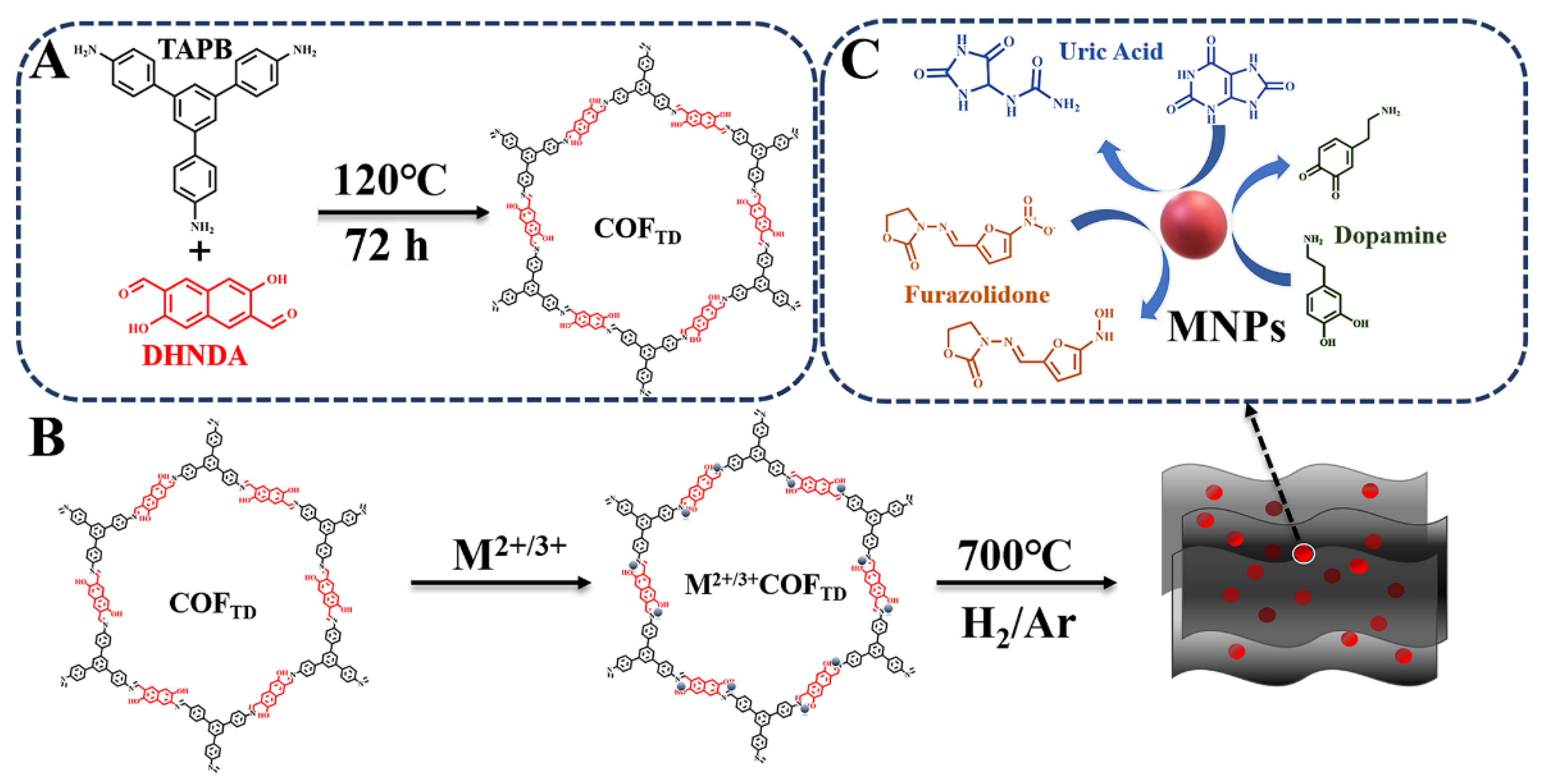
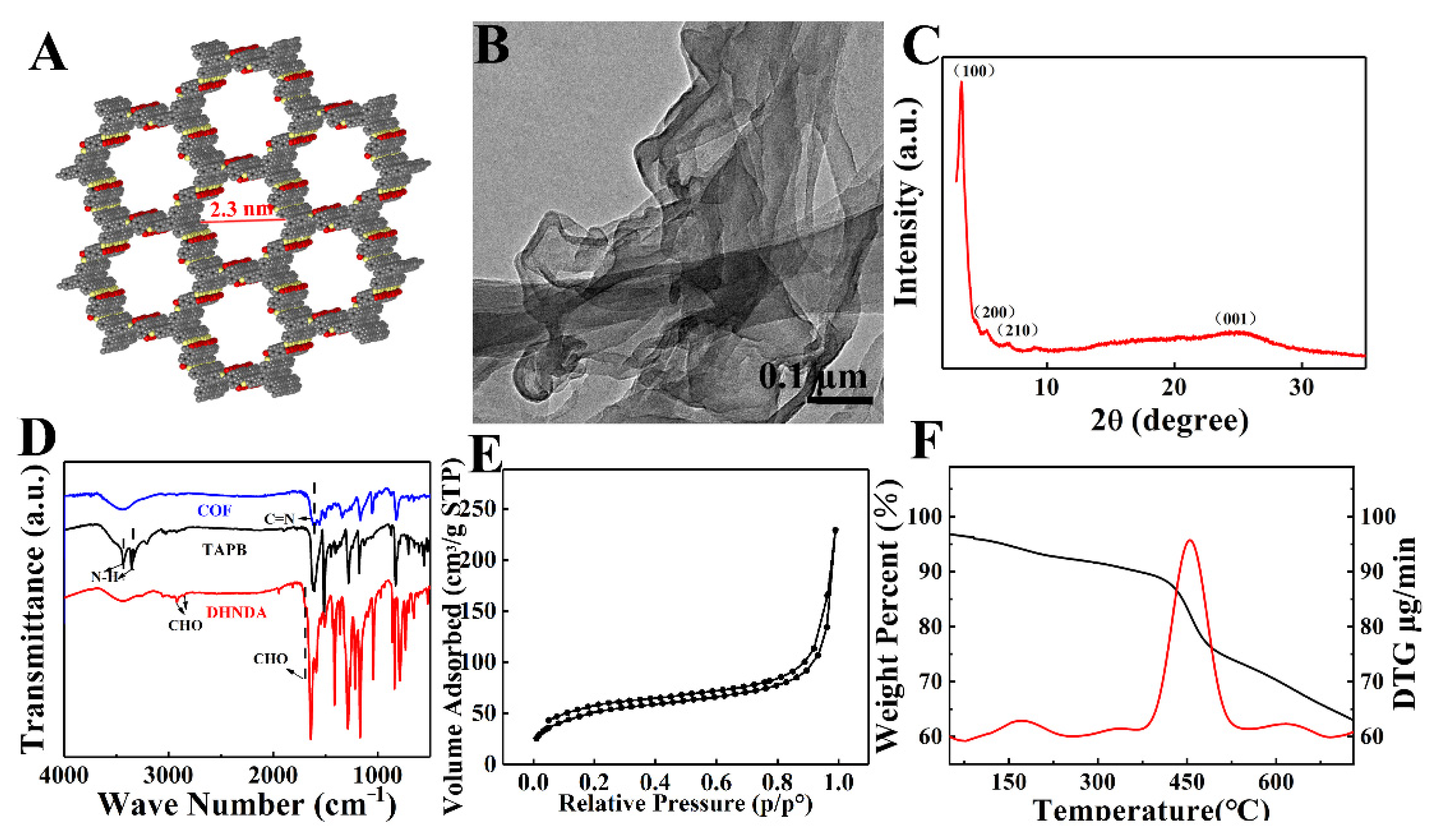
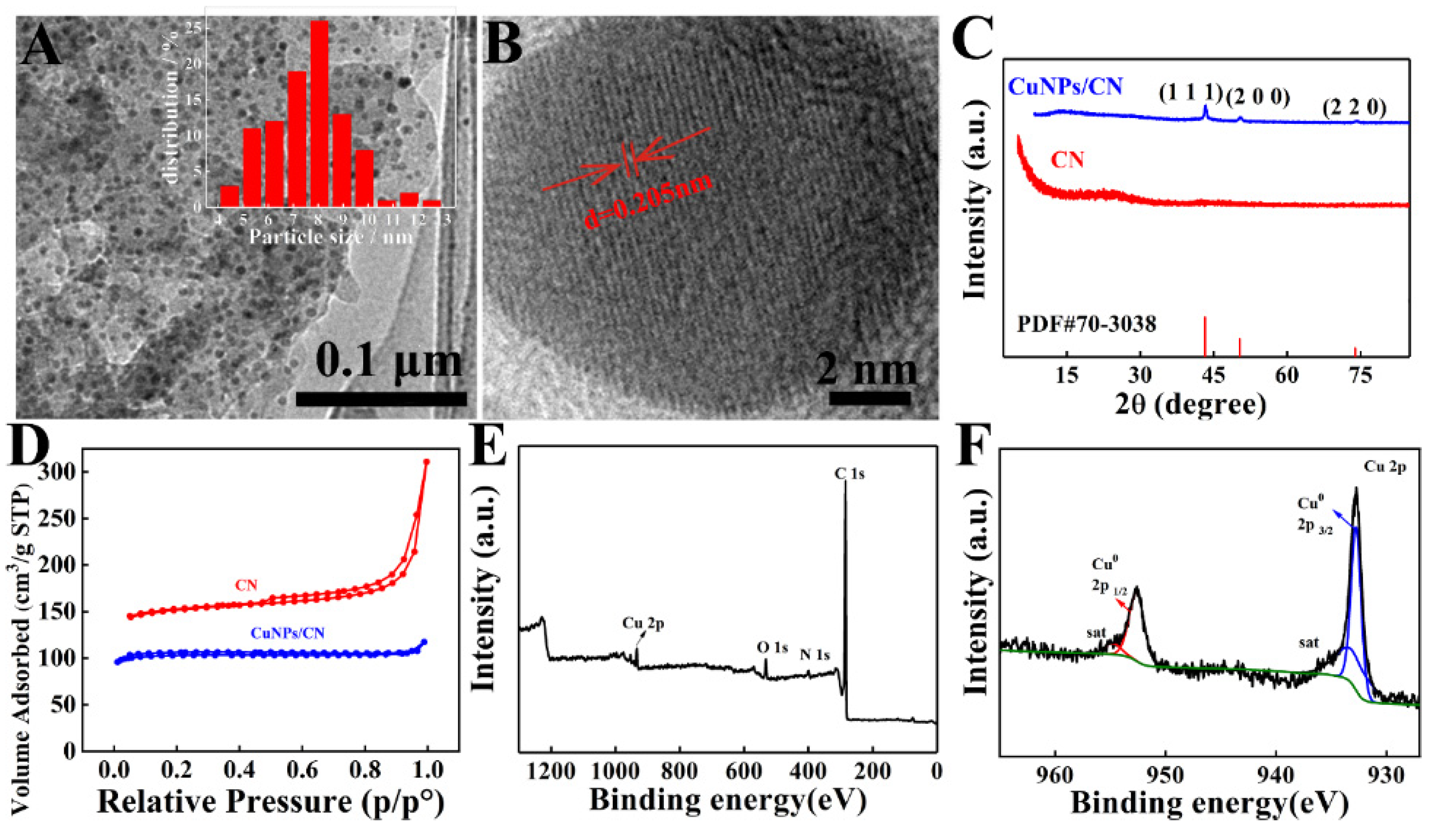
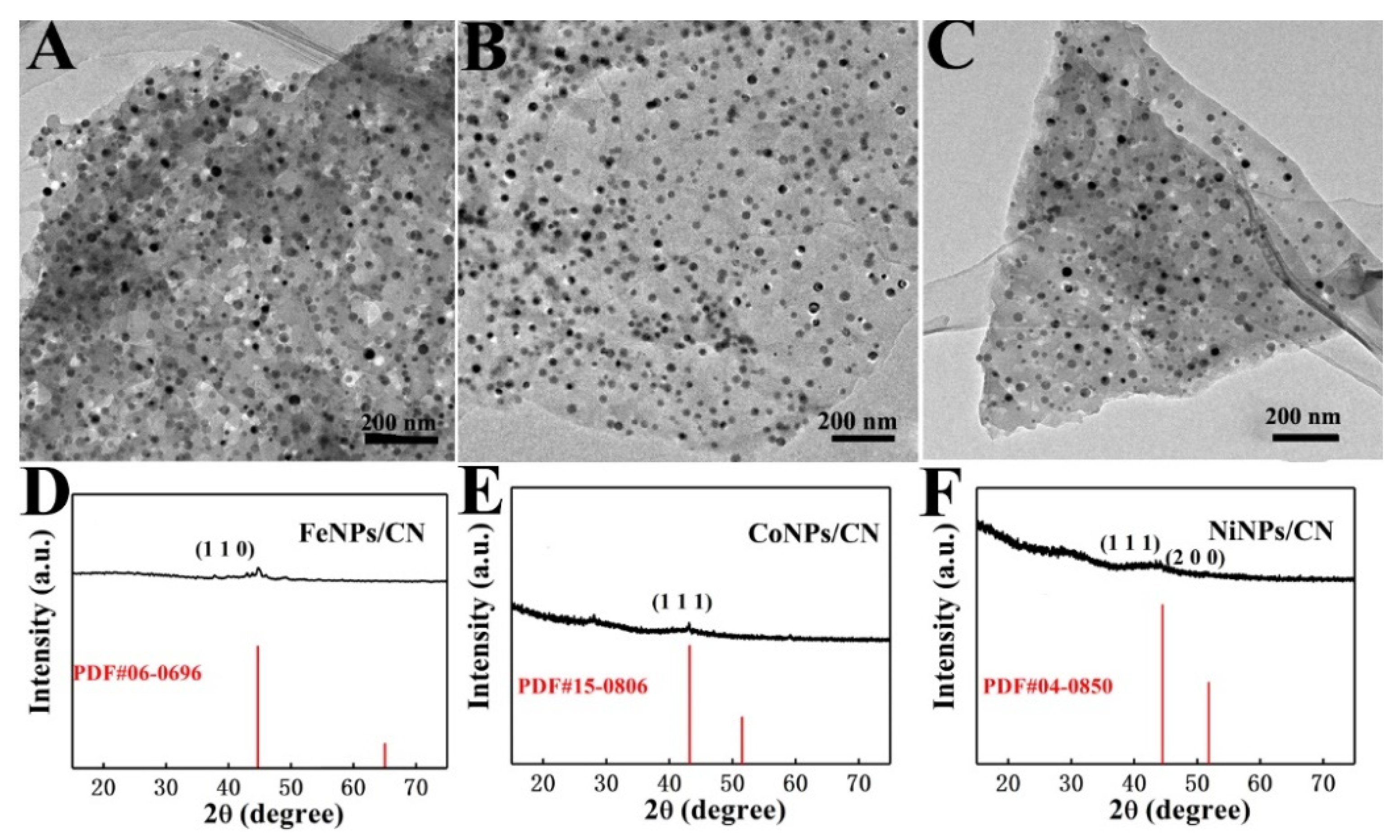
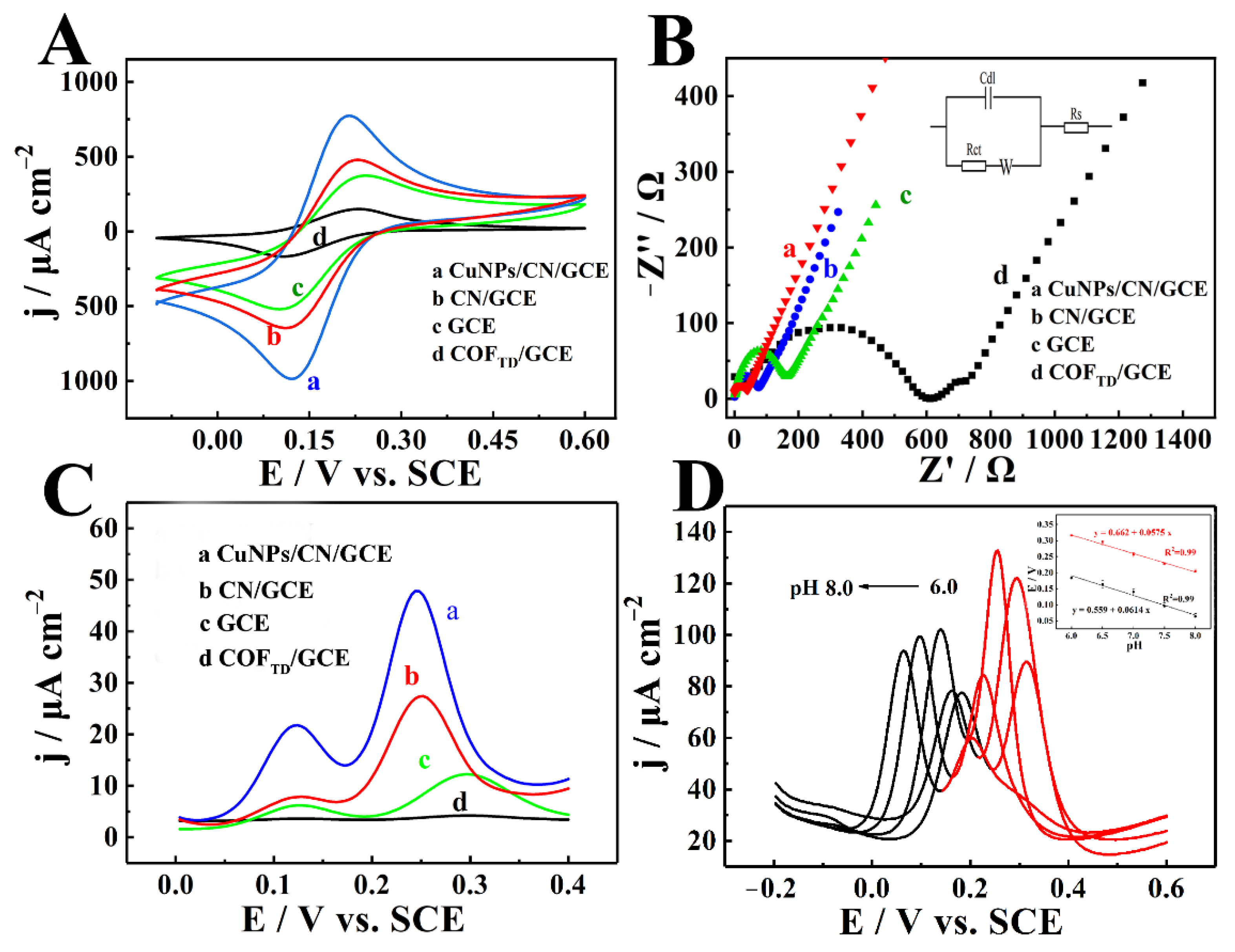
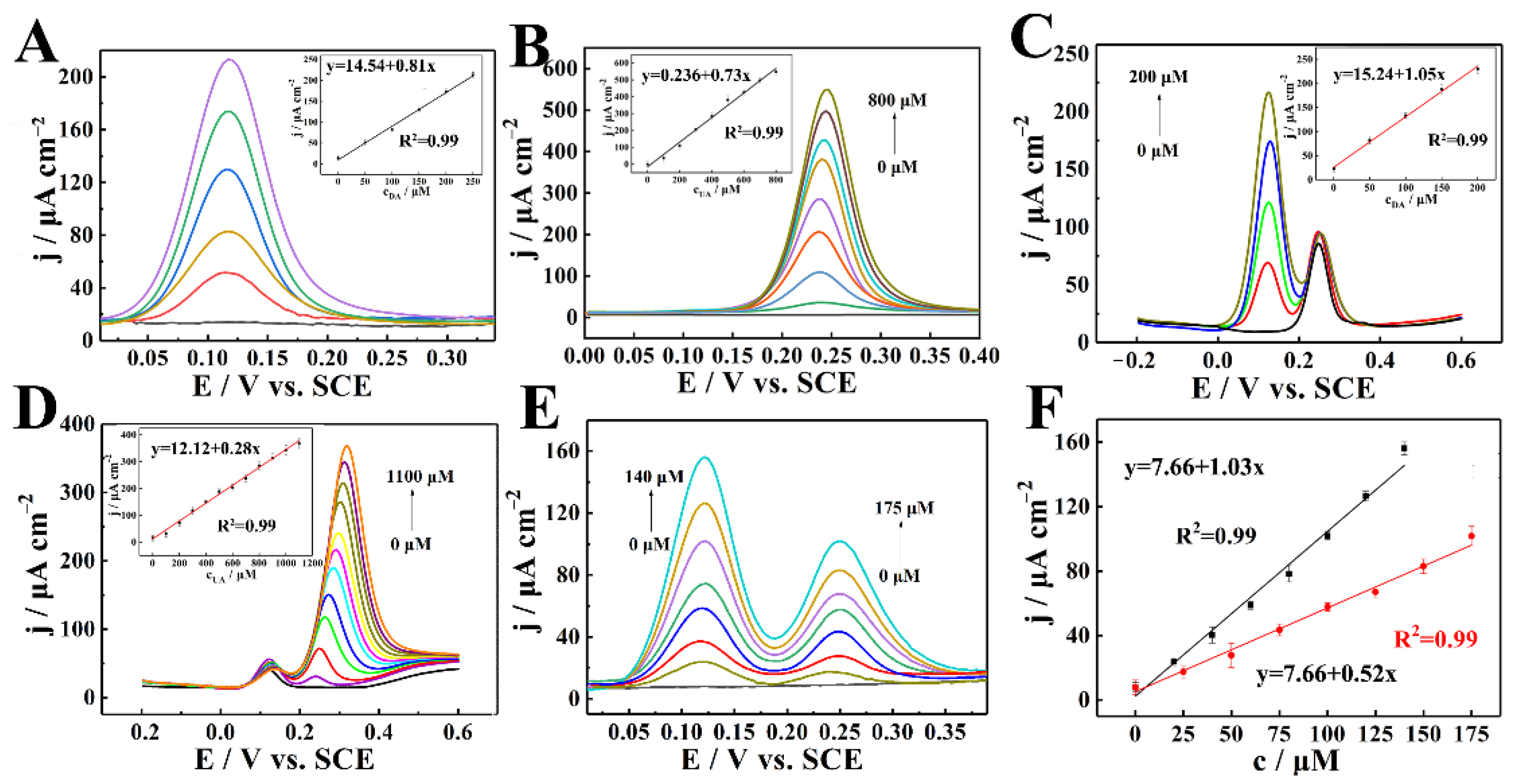


Publisher’s Note: MDPI stays neutral with regard to jurisdictional claims in published maps and institutional affiliations. |
© 2022 by the authors. Licensee MDPI, Basel, Switzerland. This article is an open access article distributed under the terms and conditions of the Creative Commons Attribution (CC BY) license (https://creativecommons.org/licenses/by/4.0/).
Share and Cite
Xiong, J.; Yang, Y.; Wang, L.; Chen, S.; Du, Y.; Song, Y. Electrochemical Sensors Based on Metal-Porous Carbon Nanozymes for Dopamine, Uric Acid and Furazolidone. Chemosensors 2022, 10, 458. https://doi.org/10.3390/chemosensors10110458
Xiong J, Yang Y, Wang L, Chen S, Du Y, Song Y. Electrochemical Sensors Based on Metal-Porous Carbon Nanozymes for Dopamine, Uric Acid and Furazolidone. Chemosensors. 2022; 10(11):458. https://doi.org/10.3390/chemosensors10110458
Chicago/Turabian StyleXiong, Jianhui, Yuxi Yang, Linyu Wang, Shouhui Chen, Yan Du, and Yonghai Song. 2022. "Electrochemical Sensors Based on Metal-Porous Carbon Nanozymes for Dopamine, Uric Acid and Furazolidone" Chemosensors 10, no. 11: 458. https://doi.org/10.3390/chemosensors10110458




